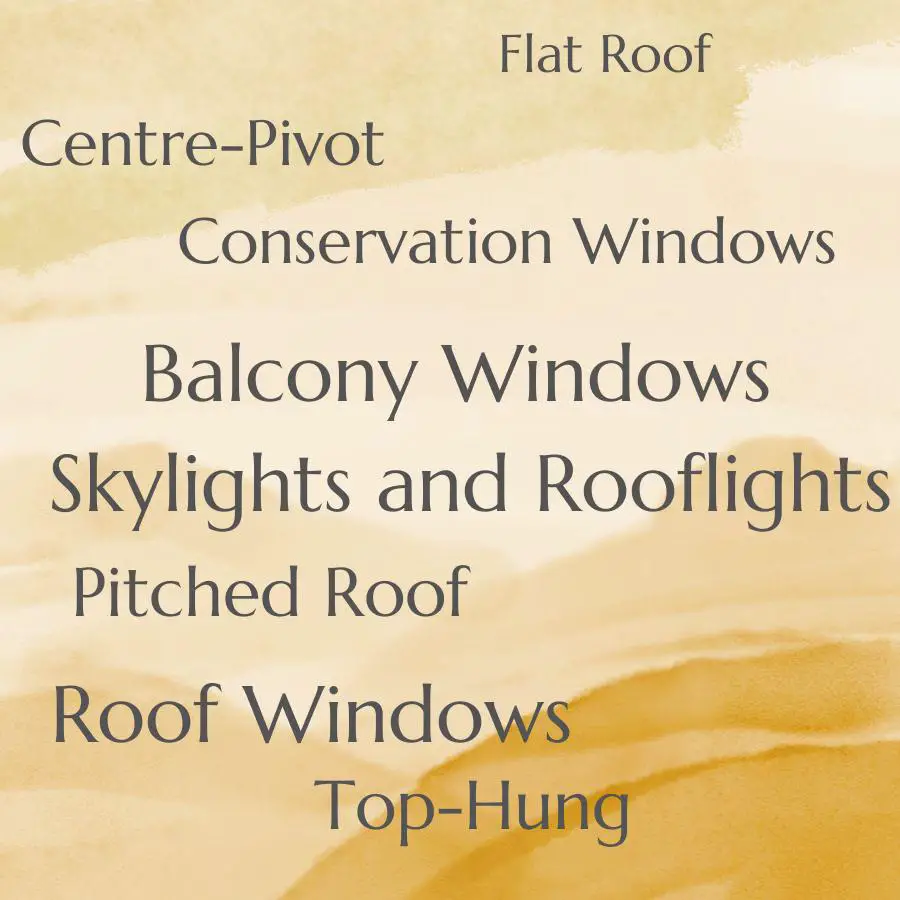Last updated on
Discover the various types of roof windows that can transform your living space by providing natural light, ventilation, and striking design elements in this informative guide.
Are you looking to add some natural light and fresh air to your home? Roof windows might just be the answer! These unique windows can transform any room by letting in more sunlight, improving ventilation, and adding a touch of style. But with so many types of roof windows available on the market, it can be overwhelming to choose the right one for your home.
In this article, we’ll take a closer look at some popular types of roof windows and help you make an informed decision. So let’s dive in!
Types of Pitched Roof Windows

Pitched roof windows are a popular choice for homeowners who want to add natural light and ventilation to their living space. These types of windows are designed specifically for sloping roofs, making them an ideal solution for attics, lofts, and other rooms with angled ceilings.
One type of pitched roof window is the centre-pivot window. This style features a hinge in the middle that allows it to open inward or outward from the center point.
Centre-pivot windows are easy to operate and provide excellent ventilation.
Another option is top-hung windows which have hinges at the top allowing them to be opened outwards from below creating more headroom inside your room than centre pivot models would allow.
Conservation Windows offer traditional styling while providing modern energy efficiency standards by using double glazing units with low-E coatings on both panes of glass as well as argon gas filling between those panes which helps reduce heat loss through conduction (the transfer of heat through solid materials).
Centre-Pivot Windows
These windows have a hinge in the middle, allowing them to pivot and open from the centre. This design makes it easy to clean both sides of the glass from inside your home, as well as providing excellent ventilation.
One advantage of Centre-Pivot Windows is their versatility – they can be installed at any height on your roof and come in various sizes to suit different spaces. They also offer an unobstructed view when opened fully, making them ideal for rooms with stunning views or where natural light is essential.
Another benefit of Centre-Pivot Windows is their ease-of-use; they typically come with handles located at the bottom or top for easy opening and closing without requiring much effort.
Top-Hung Windows
These windows open outwards from the top, allowing fresh air to circulate while keeping rainwater out. They’re also great for rooms with limited wall space, such as attics or loft conversions.
One of the main benefits of Top-Hung Windows is that they provide unobstructed views and can be installed at any height on your roof. This makes them ideal for homes with stunning views or those looking to create an airy atmosphere in their living spaces.
Another advantage of Top-Hung Windows is that they come in a range of sizes and shapes, making them suitable for different types of roofs and architectural styles. Whether you have a pitched roof or flat roof, there’s sure to be a Top-Hung Window design that will complement your home’s aesthetic appeal.
Conservation Windows
These types of roof windows are designed to blend seamlessly with traditional architecture and meet strict planning regulations.
Conservation windows come in various styles, including top-hung and centre-pivot designs. They feature slim frames that mimic the look of traditional timber frames while providing modern energy efficiency benefits.
One popular type of conservation window is the Velux Conservation Roof Window. It features an elegant black external finish that complements period properties perfectly while offering excellent thermal insulation and sound reduction qualities.
Balcony Windows
These windows open up like doors, allowing you to step out onto a balcony or terrace and enjoy the fresh air and stunning views. Balcony windows come in various sizes, shapes, and materials such as wood or aluminum frames with double-glazed glass panels.
One of the main benefits of balcony windows is that they provide easy access to outdoor spaces without taking up any floor space inside your home. They also allow for more natural light into your room while providing excellent ventilation when opened.
When choosing balcony windows, it’s essential to consider factors such as size, style preference (modern or traditional), material quality (durability), energy efficiency rating (insulation properties), security features (locks & hinges) among others.
Types of Flat Roof Windows
They offer a sleek, contemporary look that complements the clean lines of flat roofs. There are several types of flat roof windows to choose from, including fixed and opening skylights and rooflights, flat roof domes, walk-on rooflights, box windows and lanterns.
Fixed skylights provide natural light without ventilation while opening skylights allow fresh air into your space as well as sunlight. Rooflights can be installed flush with the surface or raised above it to create an upstand which helps prevent water ingress.
Flat-roof domes come in various shapes such as circular or square; they offer excellent thermal insulation properties due to their multi-layered construction making them ideal for energy-efficient buildings.
Walk-on glass is perfect if you want to create an outdoor terrace on your rooftop area while still allowing natural light into the room below. These types of window systems have been designed with safety in mind so that people can safely walk over them without any risk of falling through.
Roof lanterns add height and drama by creating a focal point within any room; they also provide additional headroom compared with other options like traditional dormer-style windows.
Fixed and Opening Skylights and Rooflights
Fixed skylights are stationary, meaning they cannot be opened or closed, but they provide a great source of natural light. They come in various shapes and sizes, including rectangular, circular or square.
On the other hand, opening skylights can be tilted open manually or electronically using remote control. This type of roof window is perfect for rooms that require ventilation such as kitchens and bathrooms.
Rooflights also come in fixed or opening options with similar features as skylights but designed specifically for flat roofs. They can either sit flush with the roof surface (flat glass) or raised above it (domed).
Flat Roof Domes
These domes come in various shapes, sizes, and materials such as glass or polycarbonate. They can be fixed or opening depending on your preference.
Fixed Flat Roof Domes are perfect for areas where you want more natural light but don’t require additional ventilation. They provide an excellent source of daylight while keeping the room insulated from outside elements.
On the other hand, Opening Flat Roof Domes offer both natural light and fresh air circulation into your living space. This type of dome is ideal for rooms that need extra ventilation like kitchens or bathrooms.
When choosing a flat roof dome, it’s essential to consider factors such as size, shape, material quality and energy efficiency rating before making any purchase decision.
Walk-On Rooflights
These roof windows are designed to be strong enough for people to walk on, making them ideal for flat roofs that double as outdoor spaces or terraces. They can also be used in basements or other areas where natural light is limited.
One of the main benefits of Walk-On Rooflights is that they provide excellent insulation, which helps keep your home warm during the winter months and cool during summer. They’re also incredibly durable and long-lasting, so you won’t have to worry about replacing them anytime soon.
When it comes to design options, Walk-On Rooflights come in a variety of shapes and sizes – from square or rectangular panels with minimal frames that blend seamlessly into your roofline -to circular domes with sleek metal trims that make a bold statement.
Roof Lanterns
These windows consist of a glazed structure that sits on top of the roof, allowing natural light to flood into the room below. Roof lanterns come in various shapes and sizes, from rectangular to circular designs.
One advantage of installing a roof lantern is its ability to create an illusion of space by making rooms appear larger than they actually are. This effect is particularly noticeable in smaller spaces such as hallways or bathrooms where natural light may be limited.
Another benefit is their energy efficiency; modern designs use double-glazed glass panels with low-emissivity coatings which help retain heat during colder months while keeping your home cool during summer months.
Box Roof Windows
These windows are designed with a sleek, modern look that can complement any home’s style. Box roof windows come in various sizes and shapes, making them suitable for different types of roofs.
One of the main advantages of box roof windows is that they provide excellent insulation against heat loss during winter months while keeping your home cool during summer months. They also offer an unobstructed view of the sky above, which can be particularly appealing if you live in an area with beautiful scenery or starry nights.
Another benefit is that box roof windows require minimal maintenance compared to other window types since they don’t have any moving parts or mechanisms prone to wear and tear over time.
If you’re looking for a stylish yet practical way to brighten up your living space while improving its energy efficiency at the same time, consider installing box roof windows on your property!.
FAQ
What are windows called in the roof?
Roof windows, also known as skylights or roof lights, are windows incorporated into a roof’s design to allow natural light into a building.
What are the different types of pitched roof windows?
Answer: The different types of pitched roof windows are centre pivot, popular for high level installations, and top hung, preferred for eye level loft installations due to their outdoor view offerings.
What are the three types of skylights?
Answer: The three types of skylights are ventilating, fixed, and tubular.
What is a window in a sloped roof called?
A window in a sloped roof is called a dormer window, also known as a dormer.
What are the advantages and disadvantages of various roof window styles?
Advantages and disadvantages of various roof window styles include increased natural light and fresh air, improved energy efficiency, and aesthetic appeal as benefits, while challenges involve potential leaks, specialized installation requirements, and increased maintenance.
How do roof window styles affect energy efficiency and insulation in a building?
Roof window styles affect energy efficiency and insulation in a building by influencing heat transfer, airflow, and the amount of natural light allowed inside.
How does the installation process differ among different types of roof windows?
The installation process for different types of roof windows varies based on factors such as window design, size, and specific requirements for each type.

